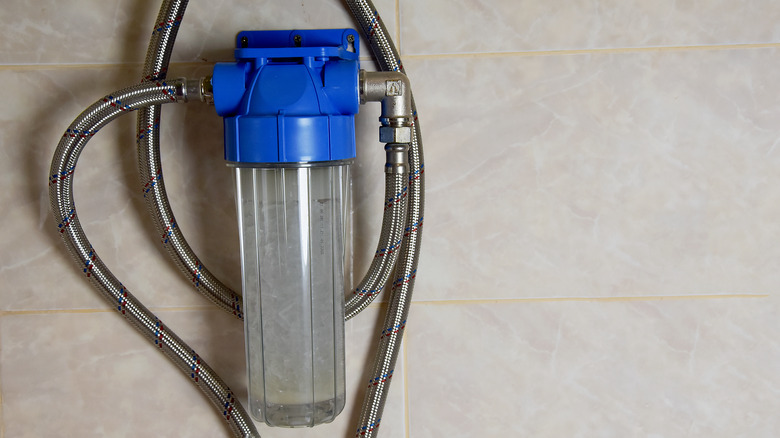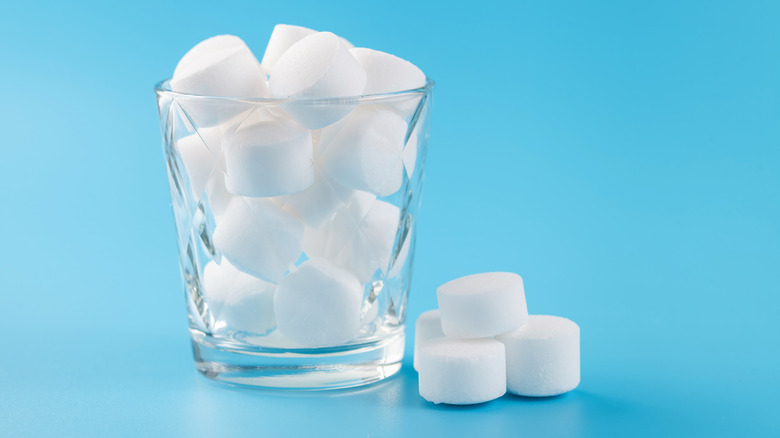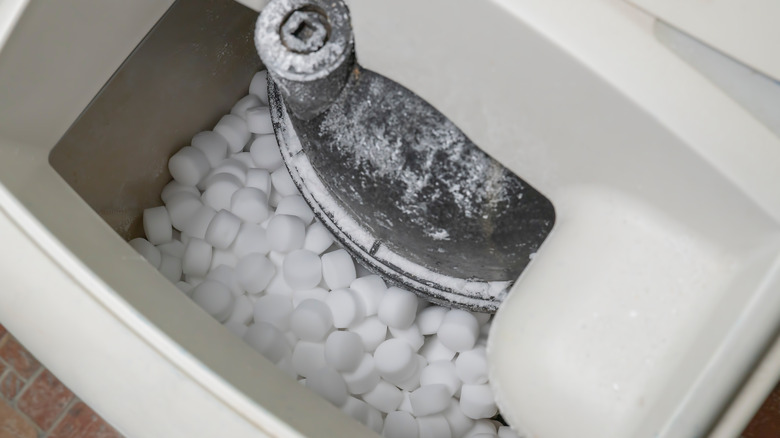What Happens If You Stop Putting Salt In Your Water Softener?
If you have a water softener in your home, you likely have hard water. This means your water contains high concentrations of minerals, including calcium and magnesium, according to USGS. Hard water can cause many problems, such as leaving mineral deposits on bathroom and kitchen fixtures, preventing soap from adequately lathering, creating stains on clothes and linens, and leaving your skin and hair dry. This is where a home water softener becomes so important; it filters the water that comes into your home and removes the excess minerals that cause problems.
You may be wondering how your water softener works. Fortunately, the system is pretty simple. Inside the softener trap are resin beads, which capture magnesium and calcium as the minerals pass through the system, as per the Minnesota Department of Health. The system also features a separate tank filled with a rock salt solution, which is designed to clean out the minerals from the resin beads every few days. This is a highly efficient system that you must properly maintain to ensure your water stays at an appropriate hardness. But we're all human, and sometimes we forget to check the system regularly. Keep reading to find out what happens when you fail to top off your water softener with salt.
Never let your water softener run out of salt
Atlas Care stresses that if you want your water softener system to continue removing the hard minerals from your water, you should do whatever is in your power never to let the brine tank run out of salt. Why? The regeneration part of the cycle that swoops in to clear the resin beads of mineral build-up cannot occur without the salt solution. If the beads fill with calcium and magnesium, they won't be able to capture any more minerals from the water flowing into your home and will be forced to let the minerals pass through into your pipes.
In addition to allowing hard minerals back into your plumbing system, Yarna points out that allowing your water softener to run out of salt can harm the appliance itself. Depending on the type of system you have, the water softener may only have one shut-off valve, which is activated by the presence of salt. Without the salt to trigger the valve to turn off, the tank may overflow with water. It's best to keep the salt tank filled to avoid unnecessary issues and costly repairs down the line.
When the problem is salt build-up
If you find that the salt in your water softener is topped off, but there are hard minerals in your water supply, you might have an entirely different issue on your hands. Sometimes, the problem is not that the system has run out of salt but that the salt is not being used properly, according to Sears. The purpose of the water softener is to reduce hard mineral build-up in your pipes. Still, ironically enough, the build-up can also occur within the water softener itself. If this happens, you'll notice something known as a salt bridge inside the tank, which is a hard layer of salt that has not dissolved and does not allow the brine water to pass through. The salt bridge can either extend horizontally across the tank or vertically along the walls, growing inwardly.
A salt bridge can mess with various water softener components, including the control valve, rotor valve, and regeneration timer. Unfortunately, the presence of a salt bridge can spell disaster for the entire water softener system, causing it to break down. The good news is that you can quickly resolve this problem by breaking up the salt bridge inside the tank into smaller pieces. The broken-up salt should sink to the bottom of the tank, allowing the brine water to circulate again and carry out the regeneration process.


